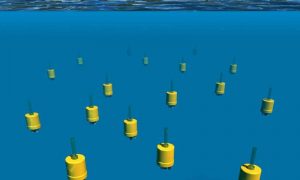 Our work on localizing small underwater robots was recently published in Nature Communications. The article describes a swarm of little underwater robots, called Mini-Autonomous Underwater Explorers (M-AUE), that can change their depth, but otherwise drift along with currents. These robots were developed in Dr. Jules Jaffe’s Laboratory for Underwater Vision. While they seem very simple, this is allows for experimentation on how ocean currents effect different types of ocean phenomenon. In particular, a swarm of these robots were used to verify, for the first time, the physical–biological interaction leading to plankton patch formation in internal waves. Our role in the project was to determine where each of these drifter moves over the course of the experiment. Typically you can rely on GPS, but that unfortunately does not work underwater. We set up our own version of GPS, using buoys instead of satellites, and acoustic signals instead of radio signals. This complicate things substantially as acoustic signal are very messy when transmitted underwater. Nevertheless, we were able to develop tracking and localization algorithms that played a key role in uncovering these scientific findings.
Our work on localizing small underwater robots was recently published in Nature Communications. The article describes a swarm of little underwater robots, called Mini-Autonomous Underwater Explorers (M-AUE), that can change their depth, but otherwise drift along with currents. These robots were developed in Dr. Jules Jaffe’s Laboratory for Underwater Vision. While they seem very simple, this is allows for experimentation on how ocean currents effect different types of ocean phenomenon. In particular, a swarm of these robots were used to verify, for the first time, the physical–biological interaction leading to plankton patch formation in internal waves. Our role in the project was to determine where each of these drifter moves over the course of the experiment. Typically you can rely on GPS, but that unfortunately does not work underwater. We set up our own version of GPS, using buoys instead of satellites, and acoustic signals instead of radio signals. This complicate things substantially as acoustic signal are very messy when transmitted underwater. Nevertheless, we were able to develop tracking and localization algorithms that played a key role in uncovering these scientific findings.
Technical Paper: A swarm of autonomous miniature underwater robot drifters for exploring submesoscale ocean dynamics, Jules S. Jaffe, Peter J. S. Franks, Paul L. D. Roberts, Diba Mirza, Curt Schurgers, Ryan Kastner & Adrien Boch, Nature Communications 8, Article number: 14189 (2017)
Media coverage: LA Times, KPBS, Phys.org, Live Science, Cosmos, Extreme Tech, New Atlas, Digital Trends.